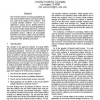Free Online Productivity Tools
i2Speak
i2Symbol
i2OCR
iTex2Img
iWeb2Print
iWeb2Shot
i2Type
iPdf2Split
iPdf2Merge
i2Bopomofo
i2Arabic
i2Style
i2Image
i2PDF
iLatex2Rtf
Sci2ools
IJCAI
2003
2003
On the Revision of Probabilistic Beliefs using Uncertain Evidence
We revisit the problem of revising probabilistic beliefs using uncertain evidence, and report results on four major issues relating to this problem: How to specify uncertain evidence? How to revise a distribution? Should, and do, iterated belief revisions commute? And how to provide guarantees on the amount of belief change induced by a revision? Our discussion is focused on two main methods for probabilistic revision: Jeffrey's rule of probability kinematics and Pearl's method of virtual evidence, where we analyze and unify these methods from the perspective of the questions posed above.
Related Content
| Added | 31 Oct 2010 |
| Updated | 31 Oct 2010 |
| Type | Conference |
| Year | 2003 |
| Where | IJCAI |
| Authors | Hei Chan, Adnan Darwiche |
Comments (0)

